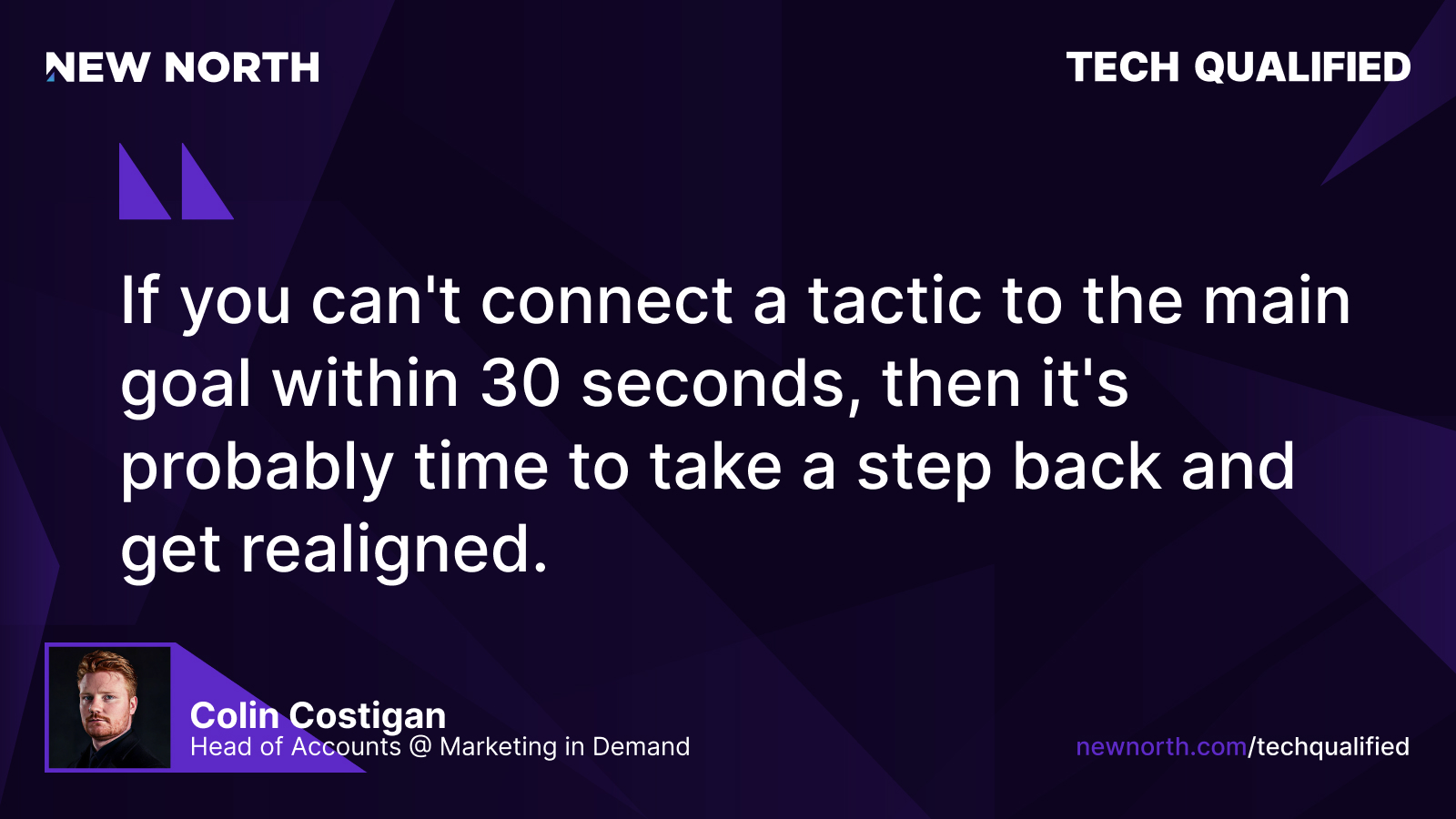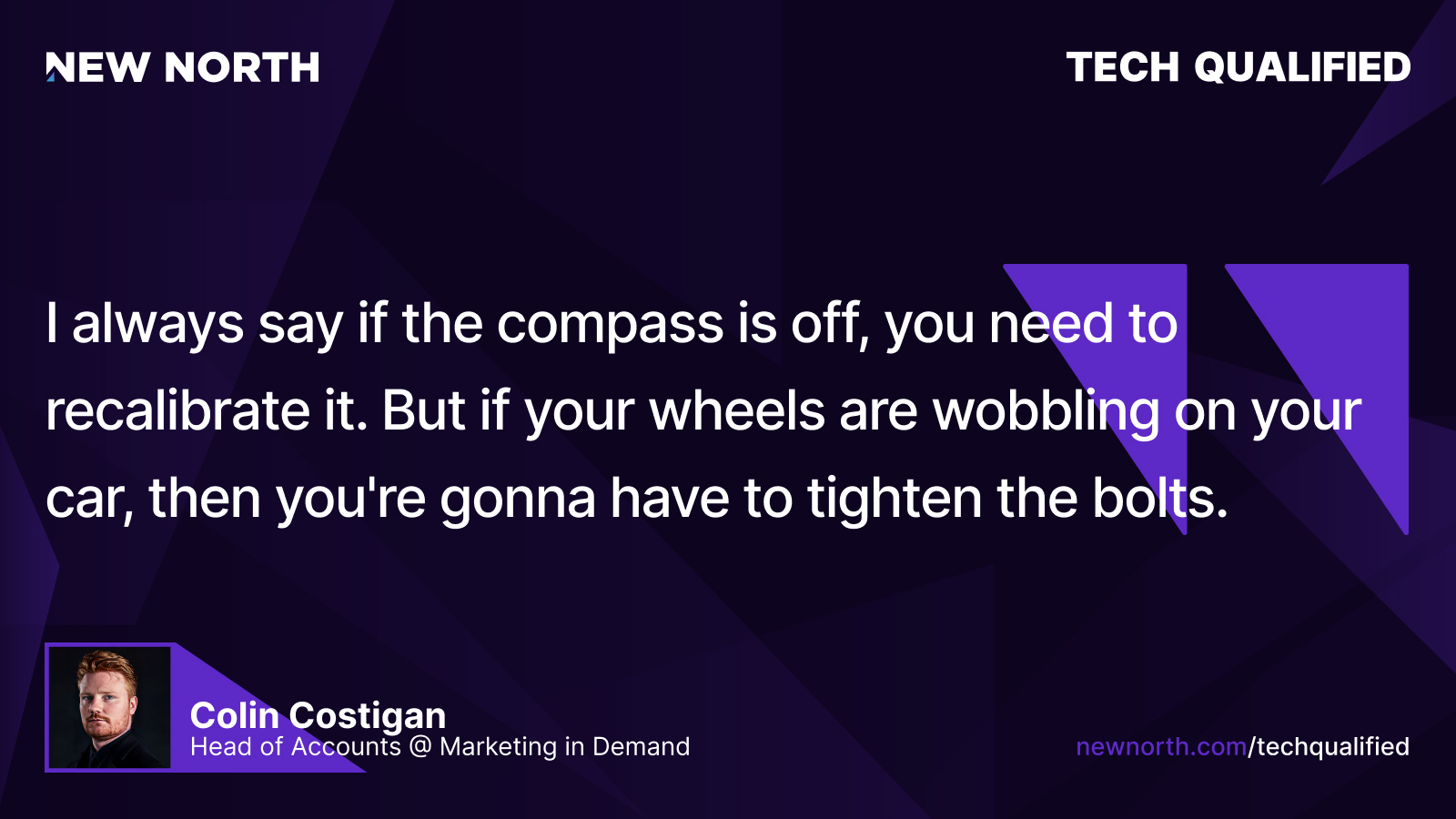Marketing teams move fast—ads launch, landing pages go live, campaigns fire off. It looks like progress. But too often, speed masks the real issue: lots of motion, little momentum.
I recently chatted with Colin Costigan, Head of Accounts at Marketers in Demand, to dig into this trap. Colin put it simply. “Great marketing is a conversation between data and intent. Goals keep us grounded. Strategy guides us. Tactics are how we adjust the sails based on how the wind is shifting.”
When you’re stuck in a loop of doing more, faster, it’s easy to lose sight of the mission.
The Pitfall of Perpetual Motion: Why Activity ≠ Progress
I have seen teams jump straight into tactics when the deadline clock starts ticking. The pressure from leadership to show something “live” right now pushes everyone into quick launches and surface-level wins. Tangible work looks like progress.
The trouble is, most of that activity stays on the surface. Colin Costigan told me, “Just putting something in motion feels like you’re making progress.” But teams end up measuring success by what is visible, not what actually delivers pipeline or revenue.
If your team does not align around the bigger picture, motion will always win out over momentum.
From Goals to Tactics: Building Your Strategic Foundation
Every time we launch a campaign, we should come back to this question: What are we actually trying to achieve? If you skip this, your team will drown in tactics that look good on a dashboard but do nothing for revenue.
Strategy sets the direction. Who are we targeting? Where do they spend time? Why would they care? These answers shape every move. When the goal is clear and the strategy is locked, tactics become tools, not distractions.
If a tactic doesn’t support the outcome, hit pause and realign. That’s how you build momentum that matters.
The 30-Second Alignment Test
Pick any tactic your team is running right now. Trace it back to your main business goal. Can you make that connection in less than thirty seconds?
If you need longer, you probably lost the plot. Run this test every quarter. Pull up an ad, an email, or a landing page. Ask the team to explain how it drives the main outcome. If nobody can do it fast, we pause the work and fix our focus.

Fluid vs. Fixed: Knowing When to Adapt
Deadline pressure makes it easy to confuse what should never change with what must. I see goals and ideal customer profiles as non-negotiable. The revenue target and who you aim to reach stay locked in unless leadership calls for a big shift. Strategy falls in the middle. Sometimes you need to flex, but only if the core approach stops working and data says so.
Tactics are always in motion. You might swap channels, test new creative, or shift offers when signals flash. Audience fatigue, rising costs, or a new competitor should prompt a fast response. Colin summed it up for me. If you spot engagement dropping or your cost per lead jumps without pipeline growth, pause. Tweak tactics first. If nothing moves, then revisit strategy.
Stay agile on tactics. Protect your goals and ICP. Let strategy flex only when signals demand it. That mix keeps your team responsive without losing sight of what matters most.
Diagnosing Problems: Is Your Compass Off or Do Your Wheels Wobble?
When your marketing engine starts to sputter, the first step is diagnosis. Are you heading in the wrong direction—or just hitting bumps in the road? If your strategy (the compass) is off, you need to recalibrate. But if the execution (the wheels) is shaky, tightening a few bolts may be all it takes.
Tactical issues show up as low-performing ads, weak offers, or fatigue across channels. These are wobbling wheels—fixable with testing, tweaks, and iteration. But if the right tactics still fail to move the needle, it’s a sign your overall direction needs adjusting.
Step back and ask: does the problem sit with the direction or the execution? Fix the compass for strategic issues. Tighten the wheels for tactical ones.

Making Every Move Serve the Mission
Purposeful marketing starts with a simple rule. Every tactic needs to serve the mission or it gets cut. If we cannot explain why this action matters for the goal, we stop and rethink.
Leaders build a culture where the team values outcomes over activity. We celebrate work that drives results, not just motion. This creates momentum that lasts, not just a busy calendar.
If a tactic does not move you closer to the outcome, change course. Real progress happens when every move fits the bigger picture. That is how sustainable growth takes root.







